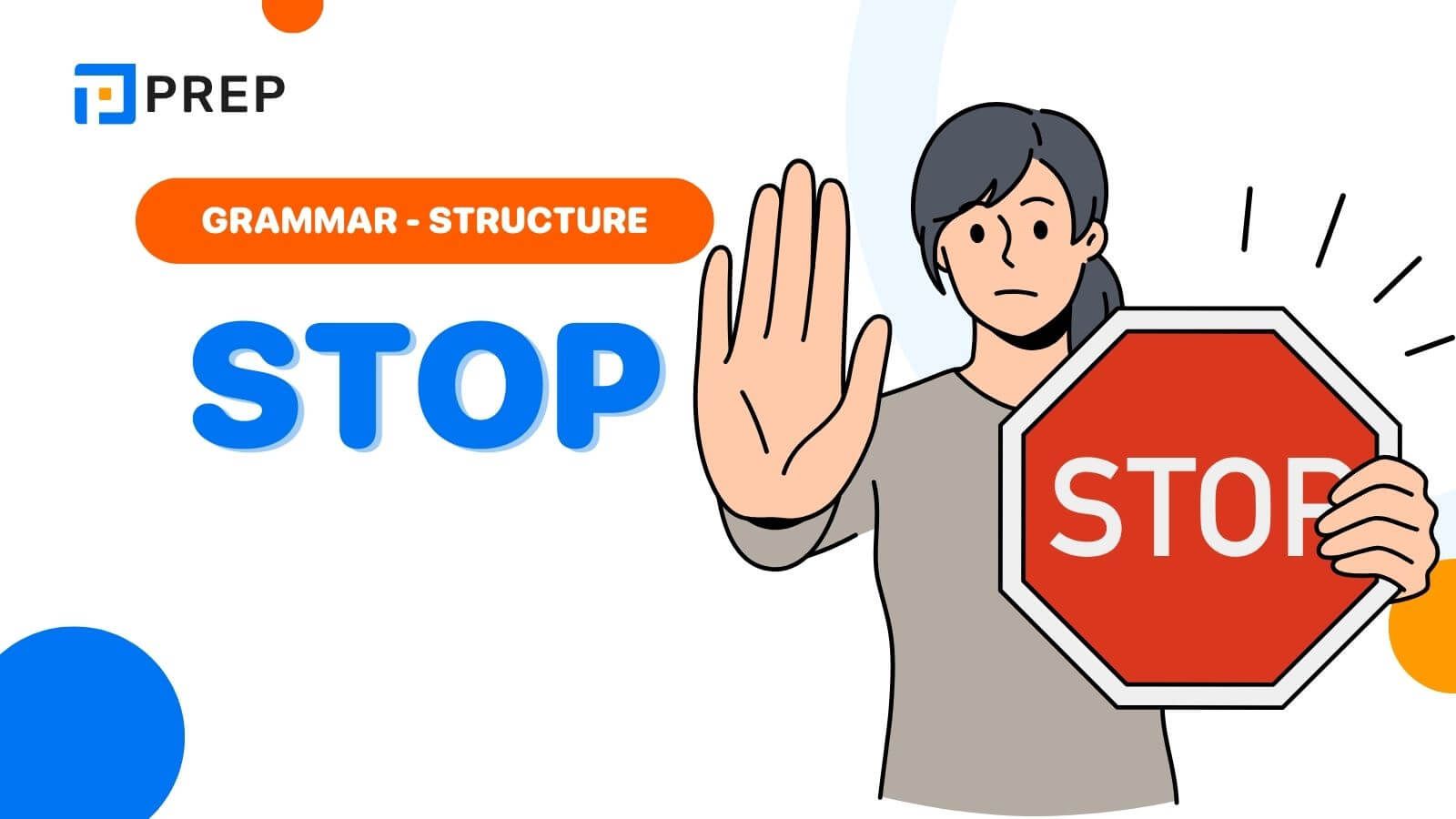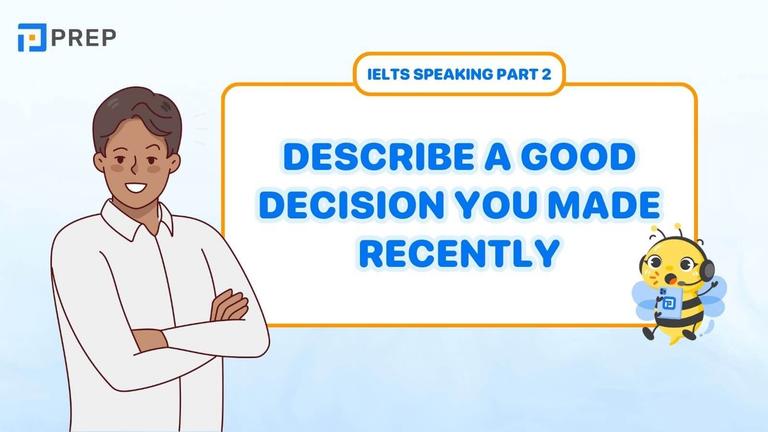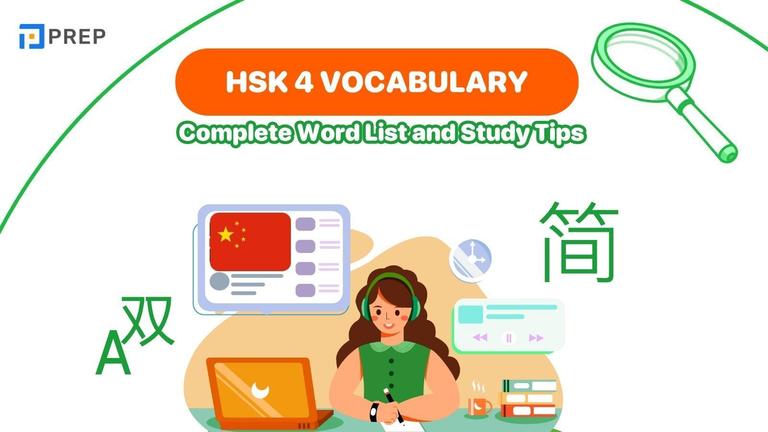Stop in English: Meaning, Grammar Rules, and Usage
The word stop in English can be used as a verb or a noun, appearing in both daily communication and academic writing. This guide explains grammar rules, phrasal verbs, collocations, synonyms, antonyms, and provides practical examples to help you use stop naturally.

I. What Does Stop in English Mean?
The word stop in English is a commonly used term in both everyday conversation and formal communication. Understanding its meanings, pronunciation, and grammatical roles will help learners use it more naturally and confidently.
In its most common form, “stop” is a verb that means to end or interrupt an action, movement, or event. It describes the act of ceasing something that was previously happening.
- Example (verb): Please stop talking during the test.
- Example (noun): The bus made a brief stop near the school.
As a noun, “stop” refers to a place or moment where something is paused or ended.
Pronunciation and Word Type
- Pronunciation (IPA): /stɒp/ (British), /stɑːp/ (American)
- Word types:
- Verb (transitive & intransitive): He stopped the car. / It stopped suddenly.
- Noun: We made a quick stop for coffee.
Knowing that “stop” can function as both a verb and a noun is important when identifying its role in a sentence. It helps learners form grammatically correct sentences and avoid confusion.
Role of Stop in Daily Communication
“Stop in English” appears frequently in spoken English and informal exchanges, especially in:
- Giving commands or requests: Stop it!, Stop right there!
- Describing habits: I stopped eating meat last year.
- Travel and movement: We stopped by her house to say hello.
It is also used in compound phrases, phrasal verbs, and expressive idioms, making it a rich and flexible word for speaking and writing. Learners who master its usage will sound more fluent and natural in both casual and structured interactions.
1. Grammar Rules of Stop in English
Understanding how to use stop in English with different grammatical structures is essential for clear and accurate communication. “Stop” can be followed by either a gerund (V-ing) or a to-infinitive (to + verb)—but each structure carries a different meaning. Additionally, “stop” can also function as a noun, especially in written and formal English.
Stop + V-ing
This structure means to end an action that is already in progress. The person was doing something, and then they stopped doing it.
stop + verb-ing
Example:
- She stopped smoking last year. → (She used to smoke, now she doesn’t.)
- They stopped talking when the teacher arrived.
Common mistake: Learners often confuse this with stopping for another reason. Make sure this form refers to ending that exact action.
Stop + to + Verb
This structure means to pause one action in order to do another. The action after “stop” is not what was stopped, but what happens next.
stop + to + base verb
Example:
- He stopped to check his phone. → (He was doing something else, then paused to check his phone.)
- We stopped to rest during the hike.
Tip: Think of it as “stop in order to...” do something.
-
For more patterns, see in order to in English.
Stop as a Noun
As a noun, “stop” refers to a pause, break, or designated place where something stops temporarily or ends.
article/determiner + stop
Example:
- Let’s take a short stop before continuing.
- This is the last bus stop on the line.
- Our trip includes several scenic stops along the coast.
Note: “Stop” as a noun is frequently used in travel, transportation, and event planning contexts.
By learning to distinguish between these structures, learners can avoid common mistakes and use “stop in English” fluently and appropriately in both speaking and writing.
-
Review article in English for choosing a/the stop.
2. Phrasal Verbs and Collocations with Stop in English
As you become more confident using stop in English, it's important to go beyond basic grammar and explore how this word naturally combines with others. Native speakers often use phrasal verbs, common collocations, and even idiomatic expressions with “stop” in everyday communication.
Learning these patterns will help your English sound more fluent, idiomatic, and contextually appropriate.
Phrasal Verbs with Stop in English
Phrasal verbs are combinations of a verb + preposition or adverb that create a new meaning. Here are some common phrasal verbs with “stop”:
|
Phrasal Verb |
Meaning |
Example |
|
stop by |
visit briefly |
I’ll stop by your office later. |
|
stop off |
make a short visit during a trip |
They stopped off at a coffee shop. |
|
stop over |
stay temporarily during travel |
We stopped over in Singapore. |
|
stop in |
make a quick visit (informal) |
Can I stop in for a few minutes? |
Note: These are often used in spoken English and travel contexts.
-
Explore more in Phrasal verbs in English.
Useful Collocations with Stop in English
Collocations are natural word combinations that commonly go together. Below are collocations with “stop” frequently found in real conversations, writing, and exams.
- stop the spread (e.g. of a disease)
- stop traffic
- stop someone from doing something
- stop immediately, stop completely, stop suddenly
- stop work, stop production
Examples:
- The government took action to stop the spread of the virus.
- Nothing could stop her from achieving her goals.
- The factory had to stop production due to safety issues.
Idiomatic Expressions Involving Stop in English
Idioms are fixed phrases with meanings that go beyond the literal interpretation. Here are several idioms with “stop”:
|
Expression |
Meaning |
Example |
|
stop at nothing |
be extremely determined |
She’ll stop at nothing to win that scholarship. |
|
stop dead in your tracks |
suddenly stop due to shock or surprise |
He stopped dead in his tracks when he saw the snake. |
|
pull out all the stops |
do everything possible |
The team pulled out all the stops to meet the deadline. |
|
come to a full stop |
completely stop; often used in driving |
You must come to a full stop at red lights. |
II. Synonyms and Antonyms of Stop in English
Expanding your vocabulary beyond just the word stop in English will help you speak and write with more variety and precision. Depending on the context, different synonyms and antonyms can express a similar or opposite idea, often with slight changes in tone or formality.
Synonyms of Stop in English
|
Word |
Meaning / Usage Context |
Example Sentence |
|
Cease |
Formal or written English |
The company ceased operations in 2020. |
|
Quit |
Informal; used with habits or jobs |
He quit smoking two years ago. |
|
Halt |
Strong command; often in military or formal orders |
The soldiers were ordered to halt. |
|
Pause |
Temporary stop or interruption |
Let’s pause the video for a moment. |
|
Discontinue |
Formal; used for services or products |
The product has been discontinued due to low demand. |
|
Break off |
Ending relationships or communication |
They broke off talks after the disagreement. |
These synonyms can replace “stop” depending on factors such as formality, tone, or context.
Antonyms of Stop in English
|
Word |
Meaning / Usage Context |
Example Sentence |
|
Start / Begin |
To initiate an action or event |
We started the meeting at 9 a.m. |
|
Continue |
To keep doing something |
Despite the interruption, she continued working. |
|
Resume |
To continue after a pause |
Class will resume after lunch. |
|
Proceed |
To go forward, especially after a pause |
You may proceed to the next question. |
These antonyms express the opposite of stopping, and are useful in both casual and academic contexts.
Stop vs. Quit in English: What’s the Difference?
Although “stop” and “quit” are often used interchangeably, they are not always the same.
- “Stop” focuses on ending an action, temporarily or permanently.
Example: She stopped working to rest. - “Quit” usually refers to permanently giving up something (often a job or habit).
Example: He quit his job last week.
In formal writing or exams, choosing the more accurate word based on context improves clarity and lexical precision.
III. How to Use Stop in English Conversation and Writing
To use stop in English effectively, learners need to understand not only its grammatical rules but also how it works in different communication settings. The usage of “stop” in everyday spoken English can be quite different from how it appears in academic or formal writing.
Using Stop in English Conversation
In spoken English, “stop” is often used in simple, direct expressions with emotional or casual tones. It’s especially common in commands, suggestions, or descriptions of everyday behavior.
Common expressions:
- Stop it! → A direct and informal command
- Can you stop making that noise? → A polite request
- He stopped by my house yesterday. → Visiting someone briefly
- Let’s stop here and get some coffee. → A suggestion to pause or take a break
- We were walking downtown when it suddenly stopped raining. → Describing events in the past
Tips for speaking:
- Use phrasal verbs for a more conversational tone (e.g. stop by, stop over).
- Use intonation and body language to express feelings (firm, polite, urgent…).
- Use “stop” to describe actions, movement, or social behavior.
Using Stop in English Writing (Academic or Formal)
In formal writing, such as essays, reports, or IELTS Writing Task 2, “stop” is often used in more structured or analytical ways.
Useful functions of "stop" in writing:
- Expressing cause and effect:
Governments must take action to stop the spread of misinformation. - Making arguments:
Some argue that stricter laws can stop illegal activities. - In academic discussions:
The program was stopped due to funding limitations.
Efforts to stop climate change require international cooperation.
Alternatives to use in writing (for variation): Prevent, eliminate, terminate, restrict, depending on the tone and context.
Tips for writing:
- Keep the formality consistent—avoid using informal phrases like Stop it! in formal essays.
- Use “stop” with object + from + V-ing to show prevention.
By learning how to use stop in English conversation and writing, you can adapt your language to the situation, enhance your fluency, and increase your score in speaking or writing tests like IELTS or TOEFL.
In this article, PREP has provided answers to the questions: "What is the Stop structure? Is it Stop Ving or to V? What prepositions does Stop go with? How is Stop used in English?" Therefore, make sure to study this article thoroughly to master these useful concepts, Preppies!

Hi I'm Chloe, and I am currently serving as an Product Content Administrator at Prep Education. With over five years of experience in independent online IELTS study and exam preparation, I am confident in my ability to support learners in achieving their highest possible scores.
Comment
Premium content
View allPersonalized roadmap
Most read












